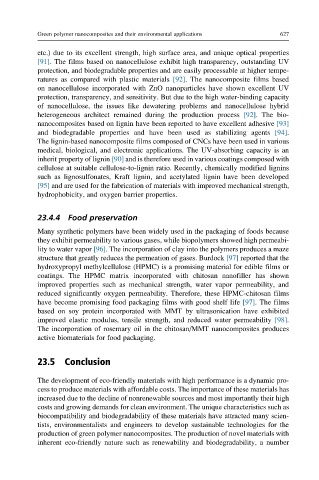Page 682 - Polymer-based Nanocomposites for Energy and Environmental Applications
P. 682
Green polymer nanocomposites and their environmental applications 627
etc.) due to its excellent strength, high surface area, and unique optical properties
[91]. The films based on nanocellulose exhibit high transparency, outstanding UV
protection, and biodegradable properties and are easily processable at higher tempe-
ratures as compared with plastic materials [92]. The nanocomposite films based
on nanocellulose incorporated with ZnO nanoparticles have shown excellent UV
protection, transparency, and sensitivity. But due to the high water-binding capacity
of nanocellulose, the issues like dewatering problems and nanocellulose hybrid
heterogeneous architect remained during the production process [92]. The bio-
nanocomposites based on lignin have been reported to have excellent adhesive [93]
and biodegradable properties and have been used as stabilizing agents [94].
The lignin-based nanocomposite films composed of CNCs have been used in various
medical, biological, and electronic applications. The UV-absorbing capacity is an
inherit property of lignin [90] and is therefore used in various coatings composed with
cellulose at suitable cellulose-to-lignin ratio. Recently, chemically modified lignins
such as lignosulfonates, Kraft lignin, and acetylated lignin have been developed
[95] and are used for the fabrication of materials with improved mechanical strength,
hydrophobicity, and oxygen barrier properties.
23.4.4 Food preservation
Many synthetic polymers have been widely used in the packaging of foods because
they exhibit permeability to various gases, while biopolymers showed high permeabi-
lity to water vapor [96]. The incorporation of clay into the polymers produces a maze
structure that greatly reduces the permeation of gases. Burdock [97] reported that the
hydroxypropyl methylcellulose (HPMC) is a promising material for edible films or
coatings. The HPMC matrix incorporated with chitosan nanofiller has shown
improved properties such as mechanical strength, water vapor permeability, and
reduced significantly oxygen permeability. Therefore, these HPMC-chitosan films
have become promising food packaging films with good shelf life [97]. The films
based on soy protein incorporated with MMT by ultrasonication have exhibited
improved elastic modulus, tensile strength, and reduced water permeability [98].
The incorporation of rosemary oil in the chitosan/MMT nanocomposites produces
active biomaterials for food packaging.
23.5 Conclusion
The development of eco-friendly materials with high performance is a dynamic pro-
cess to produce materials with affordable costs. The importance of these materials has
increased due to the decline of nonrenewable sources and most importantly their high
costs and growing demands for clean environment. The unique characteristics such as
biocompatibility and biodegradability of these materials have attracted many scien-
tists, environmentalists and engineers to develop sustainable technologies for the
production of green polymer nanocomposites. The production of novel materials with
inherent eco-friendly nature such as renewability and biodegradability, a number

